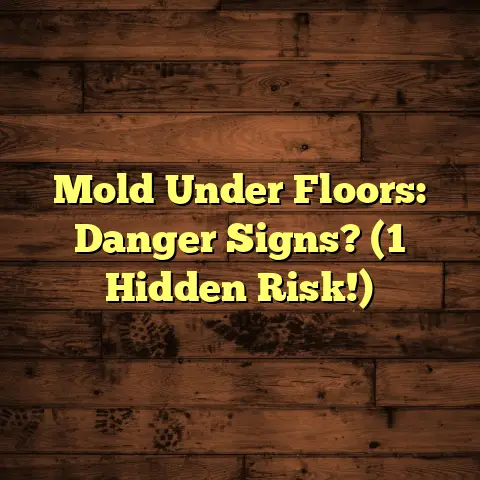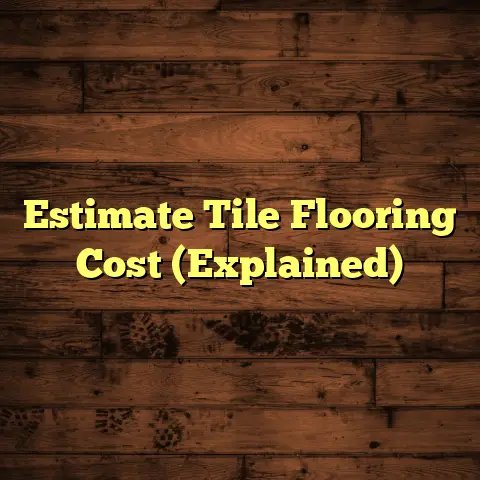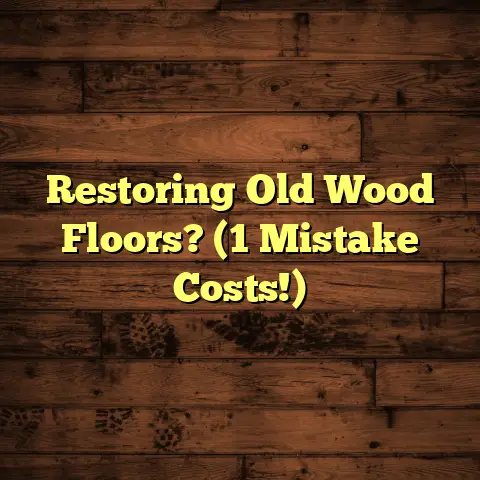Concrete Garage Floor Care (4 Pro Secrets!)
“Concrete is not just a surface; it’s the foundation of your garage’s longevity and performance. Proper care ensures it withstands the test of time.” – Tony Stewart, Lead Flooring Contractor, Stewart’s Flooring Solutions.
I’m Tony, and I’ve been knee-deep in concrete dust for over 20 years. I’ve seen it all when it comes to garage floors – from pristine showroom-worthy surfaces to cracked, stained messes. Believe me, a little TLC goes a long way.Maintaining your garage floor isn’t just about aesthetics; it’s about protecting a valuable part of your property, preventing costly repairs, and ensuring a safe workspace. Let’s dive into the secrets I’ve learned over the years.
Understanding Concrete Garage Floors
So, what exactly is a concrete garage floor? Simply put, it’s a poured concrete slab that serves as the base of your garage. But it’s more than just a gray surface.
Concrete offers a ton of benefits:
- Durability: Concrete is tough! It can handle heavy vehicles, dropped tools, and the general wear and tear of garage life.
- Cost-Effective: Compared to other flooring options, concrete is relatively inexpensive to install.
- Versatility: You can customize concrete with different finishes, colors, and coatings to match your style.
Now, let’s talk about finishes. You’ve probably seen a few different types:
- Smooth Finish: This is your basic, troweled concrete. It’s easy to clean but can be slippery when wet.
- Broom Finish: This adds a textured surface for better traction. It’s great for preventing slips and falls.
- Stained Concrete: This uses acid-based or water-based stains to add color and visual appeal.
- Epoxy Coating: This is a durable, high-gloss coating that protects against stains, chemicals, and abrasion. (More on this later!)
Even with all its benefits, concrete isn’t invincible. Here are some common problems I see:
- Cracking: Temperature changes, settling, and heavy loads can cause cracks to form.
- Staining: Oil, grease, and other fluids can penetrate the concrete and leave unsightly stains.
- Spalling: This is when the surface of the concrete starts to flake or crumble, usually due to moisture and freeze-thaw cycles.
These problems don’t have to spell disaster. With the right care, you can keep your concrete garage floor looking great for years to come.
Pro Secret #1 – Regular Cleaning and Maintenance
Think of your garage floor like your car – it needs regular cleaning to stay in top shape. Dirt, grime, and spills can quickly build up and cause staining or even damage the concrete over time.
Why is regular cleaning so important?
- Prevents Staining: The longer spills sit, the more likely they are to penetrate the concrete and cause permanent stains.
- Reduces Wear and Tear: Dirt and debris can act like sandpaper, grinding away at the surface of your concrete.
- Improves Safety: A clean floor is less slippery and reduces the risk of accidents.
Here’s my go-to cleaning routine:
-
Sweeping: I recommend sweeping your garage floor at least once a week to remove loose dirt, leaves, and debris. A good push broom with stiff bristles is your best friend here.
-
Mopping: For general cleaning, mopping is a great way to remove surface dirt and grime. Use a mild detergent and warm water. I like to use a microfiber mop for its superior cleaning power.
-
Pressure Washing: For a deeper clean, especially if you have stubborn stains or a lot of built-up dirt, pressure washing is the way to go. Be careful not to use too much pressure, as this can damage the concrete. A pressure washer with a wide fan nozzle is ideal.
What cleaning products should you use?
- Mild Detergent: For general cleaning, a mild dish soap or laundry detergent works well.
- Concrete Cleaner: For tougher stains, use a cleaner specifically designed for concrete. These are available at most home improvement stores.
- Degreaser: For oil and grease stains, a degreaser is essential. Look for a product that’s safe for concrete.
- Avoid Acidic Cleaners: Acidic cleaners like vinegar or lemon juice can damage concrete over time.
How often should you clean?
- Sweeping: Weekly
- Mopping: Monthly (or more often if needed)
- Pressure Washing: 1-2 times per year (or as needed)
By following this simple cleaning routine, you can keep your concrete garage floor looking its best and prevent costly repairs down the road.
Pro Secret #2 – Sealing Your Concrete Floor
Okay, so you’re keeping your floor clean, great! But have you thought about sealing it? Sealing your concrete is like applying sunscreen to your skin – it protects it from the elements and keeps it looking young.
What is sealing and why is it so important?
Sealing involves applying a protective coating to your concrete floor. This coating acts as a barrier, preventing water, oil, chemicals, and other substances from penetrating the concrete.
Here’s why sealing is a must:
- Protects Against Stains: Sealants create a barrier that prevents liquids from soaking into the concrete, making it much easier to clean up spills.
- Prevents Damage: Sealants protect against damage from freeze-thaw cycles, chemicals, and abrasion.
- Extends Lifespan: By protecting against damage, sealants can significantly extend the lifespan of your concrete floor.
- Enhances Appearance: Some sealants can enhance the color and sheen of your concrete, giving it a polished look.
Types of Sealants:
There are two main types of sealants: penetrating and topical.
- Penetrating Sealants: These sealants penetrate the concrete and react with it to create a waterproof barrier. They don’t change the appearance of the concrete and are ideal for applications where you want a natural look. Silane and siloxane sealers are common examples.
- Topical Sealants: These sealants form a protective coating on the surface of the concrete. They can change the appearance of the concrete, adding color or sheen. Acrylic, epoxy, and polyurethane sealers are common types.
Choosing the Right Sealant:
The best sealant for your garage floor depends on your needs and preferences. Here’s a quick guide:
| Sealant Type | Pros | Cons | Best For |
|---|---|---|---|
| Penetrating | * Natural look * Doesn’t change appearance * Breathable * Long-lasting | * Doesn’t provide as much stain protection as topical sealants * Can be more expensive | * Garages where you want a natural concrete look * Areas with high moisture levels |
| Topical (Acrylic) | * Affordable * Easy to apply * Provides good stain protection | * Not as durable as epoxy or polyurethane * Can yellow over time | * Garages where budget is a concern * Low-traffic areas |
| Topical (Epoxy) | * Extremely durable * Resistant to chemicals and abrasion * Provides a high-gloss finish | * More expensive than acrylic * Can be slippery when wet * Requires careful surface preparation | * High-traffic garages * Garages where you want a durable, chemical-resistant finish * Garages used for automotive work |
| Topical (Polyurethane) | * Durable * Resistant to UV light and chemicals * Provides a flexible, impact-resistant finish * Good abrasion resistance | * More expensive than acrylic * Can be difficult to apply | * Garages with heavy equipment * Garages exposed to sunlight * Garages where you want a flexible, impact-resistant finish |
Sealing Your Concrete Floor: A Step-by-Step Guide
Okay, ready to get your hands dirty? Here’s how to seal your concrete garage floor:
-
Preparation:
- Clean the Floor: Thoroughly clean the floor to remove all dirt, grease, and debris. I recommend using a concrete cleaner and a pressure washer.
- Repair Cracks: Fill any cracks or chips with a concrete patching compound. Let it dry completely before proceeding.
- Etch the Concrete: Etching opens up the pores of the concrete, allowing the sealant to penetrate better. You can use a chemical etcher or a concrete grinder. Follow the manufacturer’s instructions carefully.
- Rinse and Dry: Rinse the floor thoroughly to remove any etching residue. Let it dry completely before applying the sealant. This could take 24-48 hours.
-
Application:
-
Choose Your Tools: Depending on the sealant, you can apply it with a roller, brush, or sprayer.
- Apply the Sealant: Follow the manufacturer’s instructions for application. Apply thin, even coats, overlapping each pass slightly.
- Avoid Pooling: Be careful not to let the sealant pool in low spots.
-
Curing:
-
Allow Time to Cure: Allow the sealant to cure completely before using the garage. Curing times vary depending on the sealant, but it’s typically 24-72 hours.
- Protect the Surface: During the curing process, protect the surface from traffic and spills.
Sealing your concrete garage floor is an investment that will pay off in the long run. It will protect your floor from damage, extend its lifespan, and keep it looking great for years to come.
Pro Secret #3 – Repairing Damage Promptly
Even with the best care, concrete garage floors can still suffer damage. Cracks, chips, and spalling are common problems. The key is to address these issues promptly to prevent them from getting worse.
Common Types of Damage:
- Cracks: Cracks can be caused by temperature changes, settling, heavy loads, or impact.
- Chips: Chips are small pieces of concrete that break off the surface, usually due to impact.
- Spalling: Spalling is when the surface of the concrete starts to flake or crumble, usually due to moisture and freeze-thaw cycles.
Assessing the Damage:
Before you start repairing, it’s important to assess the severity of the damage.
- Hairline Cracks: These are small, narrow cracks that are usually not a cause for concern. They can be sealed with a concrete crack sealer to prevent water from entering.
- Wide Cracks: These are wider than 1/8 inch and may indicate a structural problem. Consult with a professional before attempting to repair them.
- Deep Chips: These chips extend deep into the concrete and may require a more extensive repair.
- Extensive Spalling: This indicates a serious problem and may require resurfacing or replacement of the concrete.
Repairing Minor Issues:
For minor cracks and chips, you can often do the repairs yourself. Here’s a step-by-step guide:
- Clean the Area: Remove any loose debris from the crack or chip. Use a wire brush to clean the edges.
- Prepare the Patching Compound: Mix the concrete patching compound according to the manufacturer’s instructions.
- Apply the Patching Compound: Use a trowel to apply the patching compound to the crack or chip. Overfill slightly to allow for shrinkage.
- Smooth the Surface: Use the trowel to smooth the surface of the patching compound, blending it with the surrounding concrete.
- Cure the Patch: Allow the patch to cure according to the manufacturer’s instructions. This usually takes 24-48 hours.
Materials You’ll Need:
- Concrete patching compound
- Trowel
- Wire brush
- Safety glasses
- Gloves
Why Prompt Repairs Matter:
Addressing damage promptly is crucial for several reasons:
- Prevents Further Damage: Small cracks and chips can quickly grow into larger problems if left unattended.
- Maintains Structural Integrity: Repairing damage helps maintain the structural integrity of your concrete floor.
- Improves Appearance: Repairing damage improves the appearance of your garage floor and increases its value.
- Reduces Safety Hazards: Cracks and chips can create tripping hazards.
Don’t wait until a small crack turns into a major problem. By addressing damage promptly, you can keep your concrete garage floor in top condition for years to come.
Pro Secret #4 – Preventative Measures for Longevity
Okay, you’ve got a clean, sealed, and repaired garage floor. Now, let’s talk about prevention. The best way to keep your concrete floor in good shape is to prevent damage from happening in the first place.
Strategies for Preventing Damage:
- Proper Parking: Park your vehicles carefully to avoid hitting the walls or posts of your garage. Use parking mats or guides to help you park in the same spot every time.
- Use Mats: Place mats under your vehicles to catch oil drips and other fluids. Use mats in high-traffic areas to protect the concrete from wear and tear.
- Manage Moisture: Keep your garage as dry as possible to prevent moisture damage. Repair any leaks promptly and ensure proper ventilation. Consider using a dehumidifier in humid climates.
- Avoid Harsh Chemicals: Avoid using harsh chemicals like de-icing salts on your garage floor. These chemicals can damage the concrete and cause spalling.
- Protect Against Impact: Be careful when moving heavy objects around in your garage. Use dollies or hand trucks to avoid dropping heavy items on the floor.
Seasonal Changes and Concrete:
Seasonal changes can have a significant impact on concrete. Here’s what you need to know:
- Winter: Freeze-thaw cycles can cause cracks and spalling. Apply a concrete sealer before winter to protect against moisture damage. Avoid using de-icing salts on your garage floor.
- Summer: High temperatures can cause concrete to expand and contract, leading to cracks. Keep your garage well-ventilated to prevent excessive heat build-up.
- Spring and Fall: These seasons often bring rain and moisture. Clean your garage floor regularly to remove dirt and debris that can trap moisture.
Regular Inspections:
I recommend inspecting your concrete garage floor at least twice a year – once in the spring and once in the fall. Look for cracks, chips, spalling, and other signs of damage. Address any issues promptly to prevent them from getting worse.
What to Look For During Inspections:
- Cracks: Check for new or widening cracks.
- Chips: Look for small pieces of concrete that have broken off the surface.
- Spalling: Check for flaking or crumbling concrete.
- Stains: Look for oil, grease, or other stains.
- Moisture: Check for signs of moisture, such as damp spots or efflorescence (a white, powdery substance that forms on the surface of concrete).
By taking these preventative measures, you can significantly extend the lifespan of your concrete garage floor and keep it looking great for years to come.
Conclusion
So, there you have it – my four pro secrets for maintaining a concrete garage floor:
- Regular Cleaning and Maintenance: Sweep, mop, and pressure wash regularly to prevent dirt build-up and staining.
- Sealing Your Concrete Floor: Apply a protective sealant to prevent damage from water, oil, and chemicals.
- Repairing Damage Promptly: Address cracks, chips, and spalling promptly to prevent them from getting worse.
- Preventative Measures for Longevity: Take steps to prevent damage from happening in the first place, such as proper parking, using mats, and managing moisture.
Following these tips will not only keep your garage floor looking fantastic, but it’ll also save you money on costly repairs down the line. Plus, a well-maintained garage is a safer and more enjoyable space to work in.
Don’t just stand there – get started! Your garage floor will thank you for it. And who knows, maybe you’ll even impress the neighbors with your pristine garage. Good luck!





